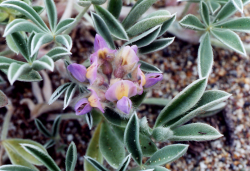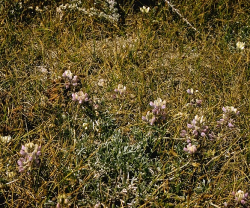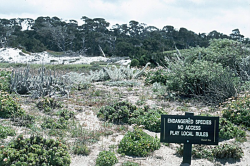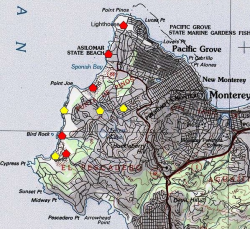
endangered


Photo taken at Lunny Ranch, Point Reyes National Seashore, Marin County © 2001 Doreen L. Smith.

Photo taken at 17-Mile Drive, Monterey County by Beatrice F. Howitt © California Academy of Sciences

Photo taken at Spanish Bay Golf Course mitigation site, Monterey County © Dean W. Taylor.

A red polygon indicates an extant occurrence; yellow indicates the occurrence has been extirpated.



This fact sheet was prepared by Grey F. Hayes and Dean W. Taylor under award NA04N0S4200074 from the National Oceanic and Atmospheric Administration (NOAA), U.S. Department of Commerce (DOC). The statements, findings, conclusions, and recommendations are those of the authors and do not necessarily reflect the views of the NOAA or the DOC.
© Copyright 2006, Elkhorn Slough Coastal Training Program
Last updated: Jun 21, 2007 19:22
Common Names - Tidestrom's lupine, clover lupine
Family - Fabaceae (Legume Family)
State Status - state endangered
(January 1987)
Federal Status - federal endangered
(June 1992)
Habitat
Coastal foredunes and adjacent sandy microsites in dune scrub vegetation and/or coastal prairie; 0-100 m.
Key Characteristics
Prostrate perennial herb to 1–3 dm tall, moderately branched, the trailing stems up to 5 dm long, generally not rooting at the nodes, white tomentose; stipules 8–12 mm long; leaves cauline, leaflets 3–5, 5–20 mm long; inflorescence open, flowers whorled; peduncles 4–8 cm long; calyx upper lip 5–6 mm, deeply notched, lower lip 5–6 mm long, entire or barely notched, petals light blue to lavender, banner back glabrous, banner patch white to yellow before pollination, violet after, upper keel margins ciliate from claw to the tip, lower keel margins glabrous (Scholars 2013). Var. layneae (not currently recognized) from Sonoma and Marin counties has non-mottled seeds, shorter peduncles (1–4 cm), and is shaggier.
Flowering Period
April to June
Reference Populations
Asilomar State Beach, 17-Mile Drive (Monterey County).
Global Distribution
Endemic to the California coast in two disjunct areas, from Point Reyes National Seashore (Marin County) north to the Russian River (Sonoma County), and in northern Monterey County on the northern Monterey Peninsula (USFWS 2009).
Nomenclature and Taxonomy
Sholars's treatment in the Jepson eFlora (2013) does not recognize the two varieties (layneae and tidestromii). Further study is needed to determine their taxonomic validity. Only Monterey County plants are state-listed endangered as L. tidestromii var. tidestromii (CNPS 2010).
Ecology
Knight's research (cited in USFWS 2009, Knight Lab 2015) has suggested that Tidestrom's lupine forms a long-lived seedbank, with seeds scarifying slowly from sand abrasion. Plants need open areas to germinate, and these are created by the shifting and movement of the sand. The presence of sand-stabilizing European beachgrass (Ammophila arenaria) appears to inhibit the germination of Tidestrom's lupine by interfering with sand movement. Removal of European beachgrass and iceplant (Carpobrotus spp.) has proved to be a highly effective means of increasing the reproductive capacity of Tidestrom's lupine (USFWS 2009). Dangremond et al. (2010) have found that European beachgrass also indirectly competes with Tidestrom's lupine by creating habitat suitable for native mice who predate the seed.
Habitat loss is still a primary threat to the conservation of this species (USFWS 2009). In 2009, the population at Asilomar State Beach was estimated to be about 1,250 plants (USFWS 2009). Some presumed extirpated occurrences consist of a few plants persisting in residential areas, both highly vulnerable but also difficult to census. Two locations have been extirpated since 1995 (USFWS 2009). Numbers have declined over the last 10 years due to climatic changes and hybridization with Chamisso's bush lupine (Lupinus chamissonis). A small population at the City of Carmel North Dune area is threatened by invasive plants, trampling, and hybridization (USFWS 2009).
Conservation
Habitat loss is still a primary threat to the conservation of this species (USFWS 2009). In 2009, the population at Asilomar State Beach was estimated to be about 1,250 plants (USFWS 2009). Some presumed extirpated occurrences consist of a few plants persisting in residential areas, both highly vulnerable but also difficult to census. Two locations have been extirpated since 1995 (USFWS 2009). Numbers have declined over the last 10 years due to climatic changes and hybridization with Chamisso's bush lupine (Lupinus chamissonis). A small population at the City of Carmel North Dune area is threatened by invasive plants, trampling, and hybridization (USFWS 2009).
Reference
CNPS, Rare Plant Program. 2010. Lupinus tidestromii, in Inventory of Rare and Endangered Plants (online edition, v8-02). California Native Plant Society, Sacramento, CA. http://www.rareplants.cnps.org/detail/1043.html [accessed 19 February 2015].
Dangremond, E. M., E. A. Pardini, and T. M. Knight. 2010. Apparent competition with an invasive plant hastens the extinction of an endangered lupine. Ecology 91(8):2261-2271.
Knight Lab. 2015. California Lupinus tidestromii. Effects of apparent competition and hybridization on the population dynamics of the federally endangered species Lupinus tidestromii in Northern Caifornia sand dunes. Department of Biology, Washington University.
Sholars, T. 2013. Lupinus tidestromii, in Jepson Flora Project (eds.). Jepson eFlora, http://ucjeps.berkeley.edu/cgi-bin/get_IJM.pl?tid=32099 [accessed 19 February 2015].
U.S. Fish and Wildlife Service. 2009. Lupinus tidestromii (Clover lupine) 5-Year Review: Summary and Evaluation. Sacramento Fish and Wildlife Office, Sacramento, California. http://ecos.fws.gov/docs/five_year_review/doc3210.pdf [accessed 19 February 2015].
